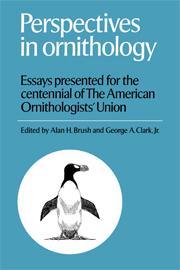 Perspectives in Ornithology
Perspectives in Ornithology Book contents
- Frontmatter
- Contents
- List of contributors
- Preface
- Introduction
- 1 Captive birds and conservation
- 2 Research collections in ornithology – a reaffirmation
- 3 On the study of avian mating systems
- 4 Cooperative breeding strategies among birds
- 5 Ecological energetics: what are the questions?
- 6 Perspectives in optimal foraging
- 7 Biochemical studies of microevolutionary processes
- 8 Organization of the avian genome
- 9 The origin and early radiation of birds
- 10 Avian community ecology: an iconoclastic view
- 11 Biogeography: the unification and maturation of a science
- 12 Bird song learning: theme and variations
- 13 Bird navigation
- Index
1 - Captive birds and conservation
Published online by Cambridge University Press: 04 August 2010
- Frontmatter
- Contents
- List of contributors
- Preface
- Introduction
- 1 Captive birds and conservation
- 2 Research collections in ornithology – a reaffirmation
- 3 On the study of avian mating systems
- 4 Cooperative breeding strategies among birds
- 5 Ecological energetics: what are the questions?
- 6 Perspectives in optimal foraging
- 7 Biochemical studies of microevolutionary processes
- 8 Organization of the avian genome
- 9 The origin and early radiation of birds
- 10 Avian community ecology: an iconoclastic view
- 11 Biogeography: the unification and maturation of a science
- 12 Bird song learning: theme and variations
- 13 Bird navigation
- Index
Summary
Many unique and spectacular birds are now threatened with extinction or decimation. For this reason, captive bird collections and propagation are attracting new interest from conservationists, and the manipulative techniques of caring for captive birds are being examined for keys to the temporary salvation of birds faltering at the edge of extinction. Such technology includes the provision of polyvinyl chloride pipe nest boxes for Puerto Rican Parrots (Amazona vittata), the “hacking” of Bald Eagles (Haliaeetus leucocephalus) and Peregrines (Falco peregrinus), and even the crossfostering of Whooping Crane (Grus americana) eggs under Sandhill Crane (Grus canadensis tabida) foster parents. Fortunately, captive propagation of birds is becoming more predictable, more science than art. Within this evolution lies a potential for the survival of some species in unconventional preservation programs including ex situ preservation, with all the ecological and philosophical uncertainties that method can impose.
Most public collections of birds – zoological gardens – are located in population centers. For an increasing number of people, they comprise the only really significant experience of birdlife that they will ever have. During the past 15 years, new exhibit techniques have allowed zoo biologists to display birds in simulated habitat groups, to sustain them better, to breed them, and to do all these things in esthetically compelling ways. One result has been heightened public consciousness.
- Type
- Chapter
- Information
- Perspectives in OrnithologyEssays Presented for the Centennial of the American Ornitholgists' Union, pp. 23 - 36Publisher: Cambridge University PressPrint publication year: 1983
- 7
- Cited by


